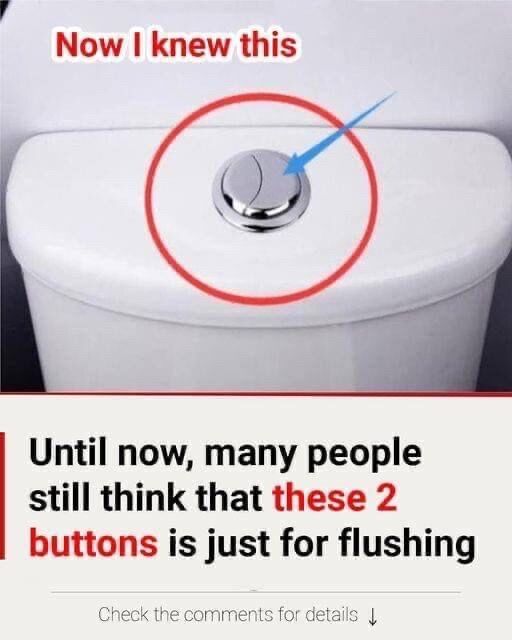Many people still don’t realize that the two buttons on modern toilets are for more than just flushing—they’re actually a simple but highly effective design intended to help conserve water. If you’ve ever looked at your toilet and noticed it has two buttons, one larger and one smaller, you might assume they both do the same thing, just with a slightly different look or feel.

d to major savings—not just for your wallet, but for the environment as well. The concept is straightforward: the larger button is designed to flush solid waste and typically releases between 6 to 9 liters of water per use, while the smaller button is intended for liquid waste and uses only about 3 to 4.5 liters per flush. By choosing the right button depending on the type of waste, you significantly reduce the amount of water used each time the toilet is flushed.
Over time, this small daily choice adds up in a big way. In fact, studies have shown that a household using a dual flush toilet properly can save up to 20,000 liters of water each year compared to homes using traditional single-flush toilets. That’s not just a number—it translates to a noticeable drop in your monthly water bill and a meaningful contribution to global water conservation efforts. Water is one of our most valuable natural resources, and in many parts of the world, it’s becoming increasingly scarce.
The dual flush system offers a practical solution that doesn’t require a drastic change in lifestyle—just a small adjustment in how we interact with something we all use every day. Although installing a dual flush toilet might cost a bit more upfront than a standard one, the long-term benefits often outweigh the initial expense. Lower utility bills and less water waste make it an investment that pays off over time, both financially and environmentally. The history behind this innovation is also quite interesting.
The dual flush concept was first introduced by Victor Papanek, a designer and sustainability advocate, in 1976. However, it wasn’t until 1980 that the idea was put into actual use, and that happened in Australia—a country known for its efforts in water conservation due to frequent droughts and limited freshwater resources. Since then, the design has spread globally, and many countries now require or encourage the use of dual flush systems in new construction and plumbing renovations. Despite its widespread availability, the feature remains underutilized or misunderstood by many people who simply see the two buttons and press one at random, unaware of the environmental and economic impact of their choice. Raising awareness about the correct use of these buttons is a small step that could lead to big change. Education is key, and it’s important for manufacturers, plumbers, and homeowners alike to spread the word. If every household with a dual flush toilet took full advantage of its design, we could see billions of gallons of water saved each year globally. That’s a powerful impact from something as simple as choosing which button to press. So next time you use a dual flush toilet, take a moment to consider what kind of flush is really needed. Press the small button when it’s just liquid waste, and save the big flush for when it’s truly necessary. This one small action, repeated over time, can make a big difference—not only in your home but for the planet. As we continue to look for practical ways to live more sustainably, making the most of innovations like the dual flush toilet is a great place to start. It’s a perfect example of how thoughtful design and informed use can work hand in hand to benefit both individuals and the greater good.





